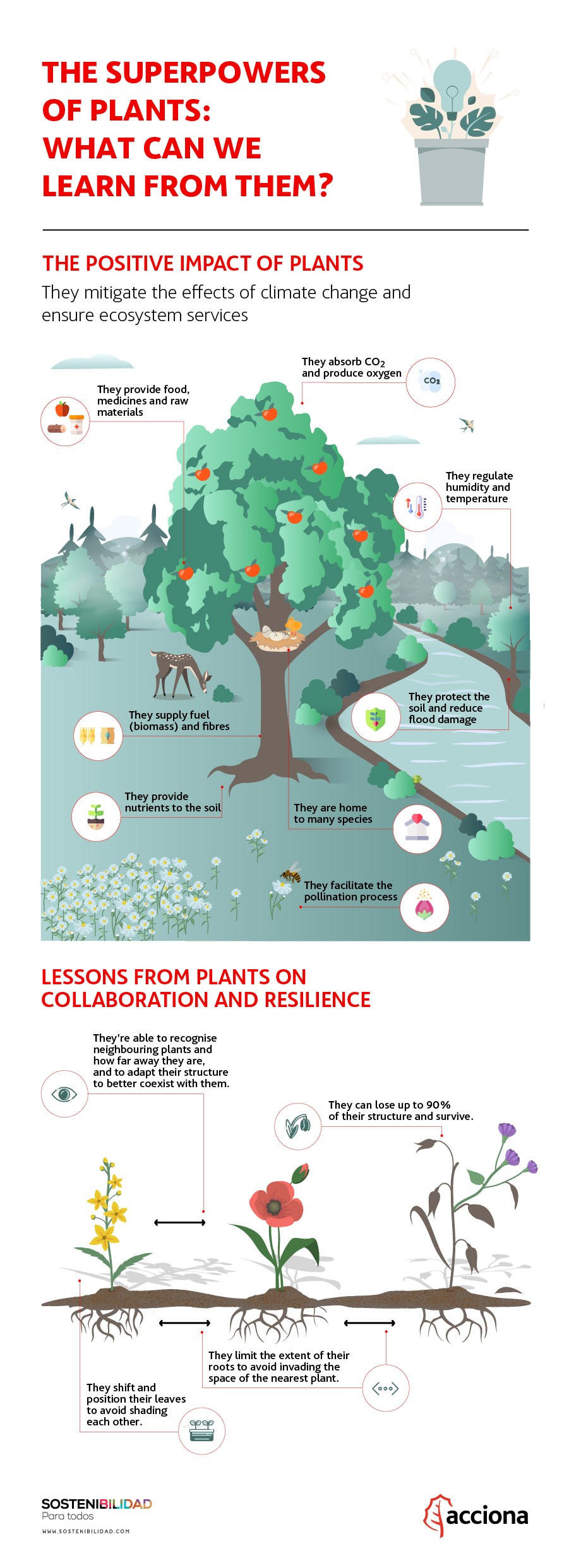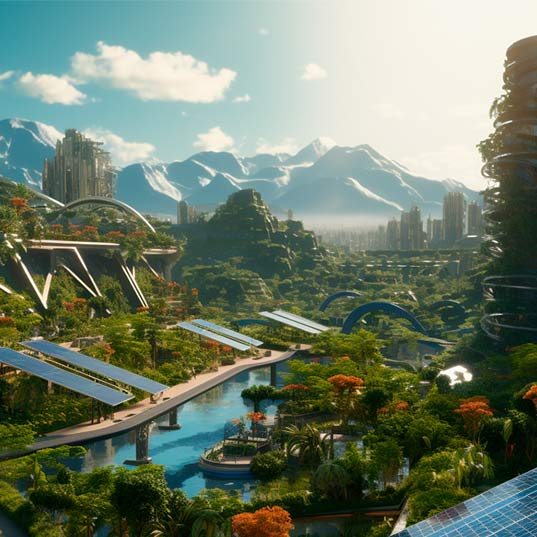Lessons from sustainable regeneration: the generous and intelligent life of plants
Understanding the capacity of plants to adapt, and the positive impact they generate in their environment, will help us embark on the sustainable regeneration the planet needs
In the 1970s, a book which affirmed that plants could read the minds of people, that they preferred classical music to rock, and were beings with emotions, shot up the bestseller list. We’re talking here about “The Secret Life of Plants” by Peter Tompkins and Christopher Bird, a book that presented curious theories about the plant kingdom and, over time, ended up being discredited by the scientific world. The work did, however, change our perception of plants – that they silently harbor valuable secrets about how, for example, we can tackle the climate crisis and care better for the environment.
What will I learn from this article?
Plants are the seed from which the environment grows
 Plants have always seemed to be so immobile and unchanging, unawares of all that’s happening around them. Living beings, but passively so. But is our problem the way we perceive them? While we are often blissfully ignorant of what they do, plants continue to provide us with the goods and services that are essential for our lives and development.
Plants have always seemed to be so immobile and unchanging, unawares of all that’s happening around them. Living beings, but passively so. But is our problem the way we perceive them? While we are often blissfully ignorant of what they do, plants continue to provide us with the goods and services that are essential for our lives and development.
They have the capacity to leave a positive impact on the planet and to generate an indispensable service for the rest of its inhabitants. They take from their surroundings the resources they need to live, but return much more to nature than they take: enriching the soil, feeding other organisms, capturing carbon dioxide… Indeed, they are a classic example of sustainable regeneration.
Thanks to plants, we have food, medicines, raw materials such as wood, fibers, and even fuel. Not to mention that they are home to a great variety of living creatures, and necessary for ecosystem services to function correctly, as we explain here. They also produce the oxygen we breathe, maintain soil quality, regulate humidity, and contribute to the stability of the climate.
“Plants produce the oxygen we breathe, maintain soil quality, regulate humidity, and contribute to the stability of the climate”
Without plants, life on Earth would quite frankly be impossible. And yet the above are just some of their better known attributes. Resilience, working together in communities, respect for the rest of nature, capacity for adaptation, are others… And beyond the goods and services they offer us, plants also teach us some interesting lessons on how we too should relate to the environment we inhabit.
The 5 lessons we can learn from the behavior of plants
While we wouldn’t go as far as saying plants have psychic (telekinetic) powers, or feel emotions, these living species do share certain admirable characteristics, especially if we consider their relationship with the environment.
Many of their most impressive abilities come from being rooted in the soil and, as such, they are unable to get up and move about when they need something or when conditions become unfavorable.
This so-called sessile lifestyle, as plant biologists call it, demands a broad, complex understanding of their environment, since plants have to find everything they need and defend themselves while remaining in one place.
🍎 They are a source of food to us, while simultaneously nourishing the soil
A study by the Food and Agriculture Organization (FAO) of the United Nations points out that pulses, as well as helping the fight against hunger with their excellent nutritional value, also facilitate climate regulation, protect ecosystems and, of course, conserve soil.
These seeds and their plants can (through certain bacteria) fix the nitrogen in the atmosphere and stabilize phosphate ions in elements such as calcium-iron phosphates. This allows plants to benefit from these nutrients to increase the quantity of organic material in the soil, protecting biodiversity and their own fertility. A lesson in how to take resources from the Earth while also returning them in greater quantity. In essence, a lesson in sustainable regeneration.
🏜 How plants adapt to their surroundings
Rising temperatures are causing rapid changes in climate conditions in many places. In most cases, these changes are endangering the survival of whole species.
But recent research has shown that some plants can rapidly adapt to new temperatures and more frequent extreme storms and droughts. Experts say two factors make this adaptation among plants possible. To begin with, the rigid cellular walls that surround plant cells aid their efforts to avoid water loss when exposed to dry periods. The second factor is abscisic acid, a hormone regulating adaptation to drought in all plants on Earth.
🌿 The resilience of plants
When a plant is trimmed back or pulled up, it is capable of reconquering its space and growing again. Plants adapt, sprout where they can and survive with what the environment offers them. This is why they are so resilient.
Given, for instance, plants cannot escape and are often eaten, it suits them not to consist of any irreplaceable organs. As such, they can lose up to 90% of their whole without dying.
🤝 Cooperation in the plant world
Various studies published in recent years show that plants might well be able to recognize their neighbors and, in doing so, limit the extension of their roots, adjust their blooms to the characteristics of the group, and incline or displace their leaves to minimize the shade covering the rest of the plants.
Although plants don’t have nervous systems like animals to recognize relatives, they are aware of their most genetically-related peers. This means they not only perceive whether or not there’s light, or if they’ve been touched, but they know what they’re interacting with.
💧 Capable of absorbing water from the air
Certain species of plants, such as the Opuntia genus (prickly pear cacti), with its impressive capacity to adapt, have learned to absorb water from the only place they can: the atmosphere. They do this thanks to fine spines known as ‘pads’.
Everyone knows that the scarcity of freshwater is becoming a serious problem for the sustainable development of the planet. Most water on Earth is saltwater; less than 3% is freshwater.
Understanding the response of plants to the challenges they face will not mean we worry less about the climate crisis, but it will help us tackle it in a smarter way.
Sources:
- https://ial.conicet.gov.ar/adaptarse-al-silencio-las-plantas-responden-a-los-cambios-ambientales-regulando-la-maquinaria-de-silenciamiento-genico/
- https://www.science.org/content/article/once-considered-outlandish-idea-plants-help-their-relatives-taking-root
- https://ethic.es/2017/12/plantas-futuro-vegetal/








